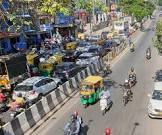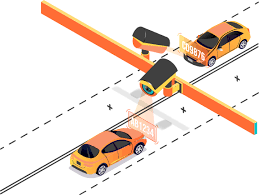Traffic: Navigating the Challenges of Urban Mobility
In today’s fast-paced world, traffic congestion has become an unavoidable reality in most urban areas. As cities grow and populations increase, the number of vehicles on the roads continues to rise, leading to longer commute times, increased pollution levels, and frustration among commuters. It is crucial to address these challenges and find sustainable solutions for efficient urban mobility.
One of the main causes of traffic congestion is the sheer volume of vehicles on the road. Rapid urbanization has led to a significant increase in car ownership, resulting in overcrowded streets during peak hours. This not only slows down travel times but also contributes to air pollution and greenhouse gas emissions.
To tackle this issue, cities around the world are adopting various strategies. One such approach is investing in public transportation systems. Efficient and well-connected public transport networks can provide a viable alternative to private vehicles, encouraging people to leave their cars at home. By expanding bus and train services, improving infrastructure, and implementing smart ticketing systems, cities can make public transport more convenient and appealing.
Another effective solution is promoting alternative modes of transportation such as cycling and walking. Encouraging citizens to choose these eco-friendly options not only helps reduce traffic congestion but also improves overall health and well-being. Cities can invest in dedicated cycling lanes, pedestrian-friendly infrastructure, and bike-sharing programs to make these modes of transport more accessible.
Furthermore, advancements in technology have opened up new possibilities for managing traffic flow efficiently. Intelligent transportation systems (ITS) use sensors, cameras, and real-time data analysis to monitor traffic conditions and optimize signal timings accordingly. This helps alleviate congestion by reducing bottlenecks at intersections and improving overall traffic flow.
In addition to these measures, city planning plays a crucial role in managing traffic effectively. By designing well-connected road networks with proper lane allocation and efficient intersection layouts, cities can ensure smoother movement of vehicles. Furthermore, implementing zoning regulations that promote mixed land-use development can reduce the need for long-distance commuting and encourage shorter trips.
However, addressing traffic congestion requires a collective effort from all stakeholders – city authorities, transport agencies, businesses, and citizens. It is essential for individuals to embrace sustainable transportation choices and consider carpooling or using ride-sharing services whenever possible. Employers can also play a role by offering flexible work hours or remote working options to reduce peak-hour traffic.
Moreover, education and awareness campaigns can help change mindsets and promote responsible driving habits. Encouraging defensive driving techniques, discouraging aggressive behaviors, and promoting adherence to traffic rules can contribute to safer roads and smoother traffic flow.
In conclusion, traffic congestion is a pressing issue that demands immediate attention. By adopting a multi-faceted approach that combines investments in public transportation, promotion of alternative modes of transport, technological advancements, efficient city planning, and individual responsibility, we can create a more sustainable and efficient urban mobility system. Together, we can navigate the challenges of traffic congestion and build cities that are not only well-connected but also environmentally friendly and livable for all.
7 Common Questions about Traffic Answered
- What is the speed limit?
- How do I get a driver’s license?
- Are there any road closures in my area?
- What are the rules for parking in this area?
- How can I avoid getting a traffic ticket?
- What are the consequences of not wearing a seatbelt?
- How can I report dangerous driving behavior to the police?
What is the speed limit?
The speed limit refers to the maximum legal speed at which a vehicle can travel on a particular road or in a specific area. Speed limits are established by local authorities and are typically indicated by signs along the road. The specific speed limits can vary depending on the type of road, location, and the country or region you are in. It is important to adhere to the posted speed limits for safety reasons and to comply with traffic laws. Speed limits are set to ensure that drivers maintain control of their vehicles, reduce the risk of accidents, and promote safe travel for all road users.
How do I get a driver’s license?
To obtain a driver’s license, you will typically need to follow these steps:
- Eligibility: Check the eligibility requirements set by your local licensing authority. Generally, you must be of a minimum age (usually 18 years or older) and meet specific medical and vision standards.
- Learner’s Permit: Apply for a learner’s permit or provisional license, which allows you to practice driving under certain restrictions. This typically involves passing a written knowledge test on traffic rules, road signs, and safe driving practices. You may also need to provide identification documents and pay the required fees.
- Driver’s Education: Complete any required driver’s education courses or training programs. Some jurisdictions may mandate a certain number of hours of classroom instruction and behind-the-wheel training with an approved instructor.
- Practice Driving: Practice your driving skills with a licensed adult who meets the requirements set by your local licensing authority. It is essential to gain experience in various traffic conditions, road types, and weather conditions.
- Road Test: Schedule and pass the practical driving test conducted by your local licensing authority. The examiner will assess your ability to operate a vehicle safely and follow traffic laws. Be prepared to demonstrate skills such as turning, parking, lane changes, signaling, and obeying traffic signs.
- Documentation: Prepare the necessary documentation for your driver’s license application, such as proof of identity, residency, and legal presence in the country if applicable. Provide any required medical certificates or clearance forms as well.
- Application Submission: Submit your completed application form along with the required documents to the appropriate licensing authority office. Pay any applicable fees at this stage.
- Written Exam: In some cases, you may also need to pass a written exam covering traffic laws and regulations specific to your locality.
- License Issuance: If you successfully complete all requirements and pass the necessary tests, you will be issued a driver’s license. The type of license (e.g., Class A, B, C) may depend on the vehicle you are allowed to operate and any additional endorsements you may have obtained.
Remember to familiarize yourself with the specific requirements and procedures set by your local licensing authority, as they can vary from one jurisdiction to another. It is advisable to visit their official website or contact their office directly for accurate and up-to-date information.
Are there any road closures in my area?
It depends on your location. You can check your local government’s website or contact your local police department for up-to-date information on any road closures in your area.
What are the rules for parking in this area?
To provide specific rules for parking in a particular area, I would need more information about the location or city in question. Parking regulations can vary significantly from one place to another. It is best to refer to local authorities, city websites, or signage in the area to obtain accurate and up-to-date information regarding parking rules and regulations.
In general, parking regulations may include guidelines on the following:
- Time restrictions: Some areas may have time-limited parking spaces where you can only park for a specified duration. This is often indicated by signage or metered parking.
- No-parking zones: Certain areas may be designated as no-parking zones due to safety concerns or traffic flow requirements. These areas are typically marked with signs indicating the restrictions.
- Permit parking: Residential areas or specific zones may require permits for parking. Only vehicles with valid permits are allowed to park in these designated areas.
- Disabled parking: Designated parking spaces for individuals with disabilities are typically marked with blue signage and require a valid disabled parking permit or license plate.
- Fire hydrant zones: It is important not to park within a certain distance of fire hydrants to ensure easy access for emergency vehicles. The specific distance can vary depending on local regulations but is usually indicated by painted curbs or signs.
- Loading zones: Loading zones are designated areas where vehicles can temporarily park for loading and unloading purposes only during specified hours. These zones are typically marked with signage and have time restrictions.
- Parking meters/pay-and-display machines: In some urban areas, you may need to pay for parking at meters or pay-and-display machines located near the parking spots. These machines usually accept coins, cards, or mobile payment options.
It is important to note that this information serves as a general guide, and local regulations may have additional rules or variations specific to your area of interest. To ensure compliance with local parking regulations, it is always recommended to consult official sources or contact local authorities for the most accurate and up-to-date information.
How can I avoid getting a traffic ticket?
Avoiding Traffic Tickets: Tips for Responsible Driving
Traffic tickets can be not only an inconvenience but also a financial burden. To minimize the chances of receiving a ticket, it is important to practice responsible driving habits and stay aware of traffic laws. Here are some tips to help you avoid getting a traffic ticket:
- Observe Speed Limits: One of the most common reasons for receiving a ticket is speeding. Always adhere to posted speed limits and adjust your speed according to road conditions. Remember, speed limits are set for your safety as well as others’.
- Follow Traffic Signs and Signals: Pay close attention to traffic signs, signals, and road markings. Stop at red lights, yield when necessary, and obey all traffic rules. Ignoring these can lead to citations.
- Use Turn Signals: Indicate your intentions by using turn signals in advance when changing lanes or making turns. This helps other drivers anticipate your actions and promotes safer driving.
- Maintain Proper Vehicle Documentation: Ensure that your vehicle registration, insurance, and license plates are up to date and easily accessible while driving. Failure to provide valid documentation can result in penalties.
- Avoid Distracted Driving: Distractions like texting, talking on the phone, eating, or grooming divert your attention from the road and increase the risk of accidents. Keep your focus on driving at all times.
- Use Seat Belts: Always wear your seat belt while driving or riding as a passenger. It is not only mandatory but also crucial for personal safety.
- Be Mindful of Parking Regulations: Familiarize yourself with parking regulations in your area to avoid parking violations such as parking in restricted zones or exceeding time limits.
- Yield Right of Way: Respect the right of way at intersections and yield when necessary, especially when entering highways or merging lanes.
- Stay Calm and Patient: Aggressive driving behaviors like tailgating or improper lane changes can lead to accidents or confrontations with law enforcement. Stay calm, patient, and follow traffic flow.
- Stay Informed: Keep yourself updated on any changes in traffic laws or regulations in your area. Awareness of new rules or modifications can help you avoid unintentional violations.
Remember, responsible driving is not just about avoiding tickets; it is about ensuring your safety and the safety of others on the road. By following traffic laws, being mindful of your surroundings, and practicing courteous driving habits, you can significantly reduce the risk of receiving a ticket while promoting a safer driving environment for everyone.
What are the consequences of not wearing a seatbelt?
Not wearing a seatbelt can have severe consequences, both for the individual involved and for others in the vehicle. Here are some of the potential outcomes of not wearing a seatbelt:
- Increased risk of injury: Seatbelts are designed to restrain occupants during sudden stops or collisions, preventing them from being thrown around inside the vehicle. Without a seatbelt, individuals are at a higher risk of being ejected from the vehicle or colliding with other objects within it, leading to more severe injuries.
- Higher chance of fatality: Studies have consistently shown that wearing a seatbelt significantly reduces the risk of death in motor vehicle accidents. When unrestrained, occupants are more likely to be thrown out of the vehicle during a crash, resulting in fatal injuries.
- Impact on others: In addition to personal safety, not wearing a seatbelt can also affect other passengers inside the vehicle. Unrestrained occupants can become projectiles during a collision, potentially causing harm to others who are properly restrained.
- Legal consequences: In many jurisdictions, not wearing a seatbelt is against the law and can result in fines or penalties if caught by law enforcement officers.
- Insurance implications: Insurance companies may consider not wearing a seatbelt as negligence on the part of the individual involved in an accident. This could impact insurance claims and coverage.
- Psychological trauma: Surviving or witnessing an accident without using a seatbelt can lead to long-lasting psychological trauma for both individuals involved and their loved ones.
It is important to note that these consequences apply to all passengers in a vehicle, regardless of their seating position or age. Wearing seatbelts should be seen as an essential safety measure that helps protect lives and minimize injuries in case of accidents on the road.
How can I report dangerous driving behavior to the police?
If you witness dangerous driving behavior on the road and want to report it to the police, here are the steps you can follow:
- Safely gather information: Note down important details about the incident, such as the date, time, and location of the incident. Try to remember the license plate number, make, and model of the vehicle involved. If possible, take photos or videos as evidence without compromising your safety or breaking any laws.
- Pull over or find a safe place: Once you have gathered necessary information and ensured your safety, pull over to a safe location or find a suitable stopping point before contacting the police. It is crucial not to use your phone while driving.
- Call emergency services: Dial the emergency number in your country (such as 911 in the United States) to reach law enforcement authorities. Inform them about the dangerous driving behavior you witnessed and provide all relevant details. Remain calm and provide accurate information to assist them in their investigation.
- Provide a detailed description: When reporting the incident, be prepared to provide a detailed description of what you witnessed. Include specifics such as vehicle color, make and model, license plate number (if available), driver’s appearance (if visible), and a clear account of their dangerous behavior.
- Follow instructions from authorities: The emergency operator will guide you on further actions based on their protocols and procedures for handling such incidents. They may ask additional questions or request any supporting evidence you might have captured.
- Cooperate with law enforcement: If required by authorities, be prepared to provide an official statement regarding what you witnessed. Provide all relevant information truthfully and cooperate fully with law enforcement throughout their investigation process.
Remember that reporting dangerous driving behavior helps ensure road safety for everyone. By promptly reporting incidents to the police, you play an essential role in holding reckless drivers accountable for their actions and contributing towards safer roads in your community.



